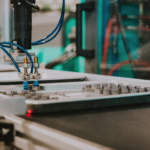Ten pivotal factors will fundamentally transform your approach to custom packaging. Emphasizing sustainability caters to eco-conscious consumers, while personalized designs forge deeper emotional connections. Striking aesthetics and innovative materials enhance brand visibility and appeal, creating a strong first impression. Leveraging professional insights guarantees compliance and boosts quality, while competitor analysis helps identify market gaps and opportunities. Efficient production techniques streamline processes and reduce costs. By aligning packaging strategies with customer preferences, you can enhance engagement and loyalty. Understanding these dynamics not only refines your brand’s identity but also affects overall market presence. Explore these transformative elements further for deeper insights.
Main Points
- Emphasizing sustainability will drive the use of eco-friendly materials, aligning packaging choices with consumer values and preferences.
- Incorporating personalization in packaging designs will foster stronger emotional connections and enhance customer loyalty.
- Leveraging innovative shapes and colors will differentiate your brand, improving shelf appeal in competitive markets.
- Utilizing technology like CAD software will streamline design and prototyping, enhancing efficiency and collaboration with manufacturers.
- Continuous competitor analysis will inform strategic packaging decisions, revealing market gaps and inspiring innovative solutions.
Custom Boxes Purpose and Benefits

Custom packaging frequently serves as a fundamental element in modern marketing strategies, as it not only captures customer attention but also enhances product visibility in a crowded marketplace.
The design of custom packaging plays a key role in brand recognition, allowing businesses to differentiate themselves from competitors. By incorporating unique branding elements, companies can create an immediate connection with potential customers, establishing a strong first impression that fosters loyalty.
Moreover, effective custom packaging is essential for protecting your products during transit and storage. By ensuring that items arrive in ideal condition, businesses can greatly increase customer satisfaction, thereby reducing return rates and enhancing overall consumer trust.
Tailored packaging designs also facilitate compliance with safety and quality standards, which further establishes credibility with consumers.
Additionally, custom packaging can streamline logistics by making transportation and stock management more efficient. This reduces logistical challenges and costs for businesses, ultimately contributing to a more sustainable operation.
Brand Identity Alignment With Custom Packaging
Effective brand identity alignment is essential for businesses aiming to establish a strong market presence and foster consumer loyalty. Customized packaging serves not only as a protective vessel for products but also as a critical extension of a brand’s image. By utilizing consistent colors, logos, and designs that resonate with core values and mission statements, businesses can greatly enhance customer recognition.
Research indicates that cohesive branding through packaging can increase brand trust by up to 81%. This underscores the importance of aligning packaging materials and designs with brand messaging.
Packaging facilitates storytelling, with 70% of consumers expressing a higher likelihood of purchasing from brands that effectively communicate their values through packaging. In addition, a strong first impression matters; 94% of first impressions are design-related, highlighting the necessity of aligning packaging aesthetics with overall brand identity.
Consistency across all product packaging reinforces brand identity, making 77% of consumers more inclined to purchase from brands that maintain uniformity.
Therefore, integrating customized packaging strategies that reflect brand identity is not merely a marketing tactic but an essential component in shaping the customer experience and driving loyalty.
Design Aesthetics Of Custom Packaging
Packaging design is a pivotal element in attracting consumer attention and influencing purchasing behavior. The integration of unique design aesthetics into custom packaging can greatly elevate shelf appeal, drawing consumers in with visually striking elements.
Innovative shapes combined with vibrant colors not only enhance the desirability of a product but also create differentiation in a crowded market, effectively setting a brand apart from its competitors.
Moreover, a well-crafted package that embodies luxury and quality can enhance the perceived value of the product, fostering customer loyalty and positive brand associations.
In contrast, a simplified and minimalistic design approach can streamline the user experience, reducing visual clutter and facilitating quick product recognition—a crucial factor in fast-paced retail environments.
Incorporating storytelling elements into packaging design opens avenues for creating an emotional connection with consumers. This strategy transforms packaging from a mere functional wrapper into a memorable component of the customer journey.
Professional Guidance With Custom Packaging
Expert collaboration in the domain of packaging design serves as a catalyst for innovation and efficiency, enabling brands to harness specialized knowledge and creativity. Engaging with industry professionals provides essential guidance that enhances the quality of custom packaging.
Experts bring valuable insights into market trends and customer preferences, ensuring that packaging not only captivates attention but also aligns with consumer expectations.
Professional guidance streamlines the product launch process by ensuring that packaging meets both aesthetic and functional requirements. This includes compliance with safety standards and a focus on user experience.
Access to advanced resources and tools provided by professionals can greatly elevate the appeal of packaging designs, making them more competitive in a saturated market.
Moreover, conducting competitive analysis with expert insights allows brands to avoid design clichés while identifying innovative solutions that stand out. By incorporating current market trends and preferences into packaging design, businesses can effectively resonate with their target audience.
In the end, leveraging professional guidance in custom packaging creates a strategic advantage, fostering both consumer engagement and brand loyalty, while ensuring a successful market presence.
Custom Packaging Audience Engagement Strategies
Engaging an audience requires a deep understanding of consumer demographics and preferences, enabling brands to create packaging that resonates on a personal level. Effective audience engagement strategies hinge on the ability to tailor custom packaging solutions that reflect customer preferences.
By employing surveys and feedback mechanisms, businesses can gather invaluable insights into expectations, thereby refining their packaging designs to enhance appeal.
Seasonal and themed packaging designs play a pivotal role in generating excitement, particularly during peak shopping periods. Such strategies not only drive customer interest but also fuel sales by creating a sense of relevance.
Moreover, analyzing competitors’ packaging strategies reveals market gaps, allowing brands to innovate and distinguish themselves from others in their niche.
Incorporating personalization elements, such as unique designs or tailored messages, fosters a deeper emotional connection with consumers. Personalized boxes not only elevate the unboxing experience but also enhance brand loyalty, reinforcing the notion that customers are valued.
In the end, the fusion of these audience engagement strategies within custom packaging can greatly elevate brand perception and drive sustained customer interaction.
Material Requirements Of Custom Boxes
Selecting the appropriate materials for custom packaging is critical to ensuring product safety and consumer satisfaction. The characteristics of the product dictate the choice of packaging material; for instance, fragile items necessitate sturdy solutions, while perishable goods require materials that maintain freshness. Understanding these nuances informs the selection process, leading to effective product packaging.
Eco-friendly packaging options, such as biodegradable and recyclable materials, are increasingly in demand due to consumer awareness and regulatory pressures. These sustainable choices not only resonate with environmentally conscious buyers but also reflect a brand’s commitment to sustainability.
Moreover, the durability and weight of packaging materials greatly influence shipping costs and product integrity during transportation. Lightweight materials are ideal for e-commerce shipments, where cost efficiency is paramount, while robust options are essential for retail displays to withstand handling.
Cardboard emerges as a versatile material, enhancing customization capabilities through its adaptability. It can be easily printed on and shaped to meet diverse requirements across various product types.
In the end, thoughtful material selection in custom packaging paves the way for enhanced brand perception and customer loyalty, proving that material choices are not merely practical but strategic.
Competitor Insights Of Custom Packaging
Analyzing competitor packaging strategies provides valuable insights that can greatly enhance a brand’s market position. By monitoring how competitors design their packaging boxes, businesses can identify emerging trends and avoid design clichés that lead to indistinct products.
Understanding competitors’ approaches to cardboard packaging not only highlights market gaps but also inspires innovation that allows a brand to differentiate itself effectively.
Furthermore, staying informed about the branding efforts reflected in packaging can spark new ideas that improve product visibility and foster a deeper connection with customers. Insight into competitors’ choices regarding materials and sustainability practices can guide a brand’s own packaging decisions, ensuring their offerings resonate with consumer preferences.
Regularly evaluating competitor packaging strategies enables businesses to make timely adjustments, keeping them relevant in an ever-evolving market landscape.
Custom Production Packaging Efficiency
In the competitive landscape of custom packaging, the ability to optimize production efficiency is paramount for businesses aiming to enhance their operational capabilities and maintain market relevance. Streamlining production processes through automation and efficient workflows greatly reduces lead times, enabling quick fulfillment of large orders. This agility not only meets urgent market demands but also leverages high-volume output capabilities to lower per-unit costs, making custom packaging more accessible.
Moreover, implementing just-in-time inventory systems minimizes waste by ensuring materials are available only when needed. Collaborating with reliable manufacturers further enhances quality control, ensuring products meet specifications and reducing rework. Leveraging technology, such as CAD software, innovates the design and prototyping phases, facilitating rapid iterations and expediting packaging development.
| Key Strategies | Benefits | Impact on Production Efficiency |
| Automation | Faster processing times | Reduced lead times |
| High-volume output | Lower per-unit costs | Affordable custom packaging |
| Just-in-time inventory | Minimized waste | Optimized resource allocation |
Customer-Centric Approach of Custom Boxes
A customer-centric approach in custom packaging emphasizes the importance of understanding consumer demographics and preferences, which are vital for developing tailored packaging designs that effectively resonate with target audiences. By prioritizing this approach, brands can create a personalized box that reflects the unique identities and desires of their customers, ultimately enhancing engagement.
Collecting and analyzing customer feedback is essential in this process, providing insights into the effectiveness of packaging solutions. This continuous improvement loop allows brands to align their offerings with consumer expectations, guaranteeing that the packaging to make resonates well with the target demographic.
Incorporating elements such as handwritten notes or special promotions within the packaging elevates the unboxing experience, fostering customer loyalty and satisfaction.
Moreover, transparency in the packaging design process fosters trust, as consumers appreciate clarity regarding costs and methodologies. Engaging customers through surveys and interactive platforms can yield valuable insights that inform packaging choices.
This guarantees that the designs not only meet functional needs but also reflect consumer values, enhancing overall satisfaction. In sum, a customer-centric approach is integral to creating impactful custom packaging that drives brand loyalty and consumer engagement.
Future Trends In Custom Packaging
As brands increasingly adopt a customer-centric approach in custom packaging, the landscape is evolving to incorporate emerging trends that align with consumer expectations and technological advancements.
The future of custom packaging is marked by key trends that enhance both the sustainability and consumer experience.
- Sustainable Packaging: With 72% of consumers willing to pay more for eco-friendly options, brands are prioritizing environmentally responsible materials.
- Personalized Experiences: As 80% of consumers prefer tailored packaging designs, brands are leveraging personalization to foster loyalty and engagement.
- Lightweight Packaging: The growth of e-commerce necessitates packaging that is not only protective but also lightweight and easy to handle, improving the online shopping experience.
- Minimalism: A shift towards minimalistic design reduces waste while emphasizing brand identity, appealing to the modern consumer’s aesthetic sensibilities.
- Unboxing Experience: Innovations in smart packaging, including QR codes and augmented reality, are transforming the unboxing experience into an interactive journey that adds value and information.
These trends reflect a significant shift in how brands approach custom packaging, emphasizing sustainability, personalization, and enhanced consumer interaction.
As these trends continue to evolve, they will define the future landscape of packaging solutions.







